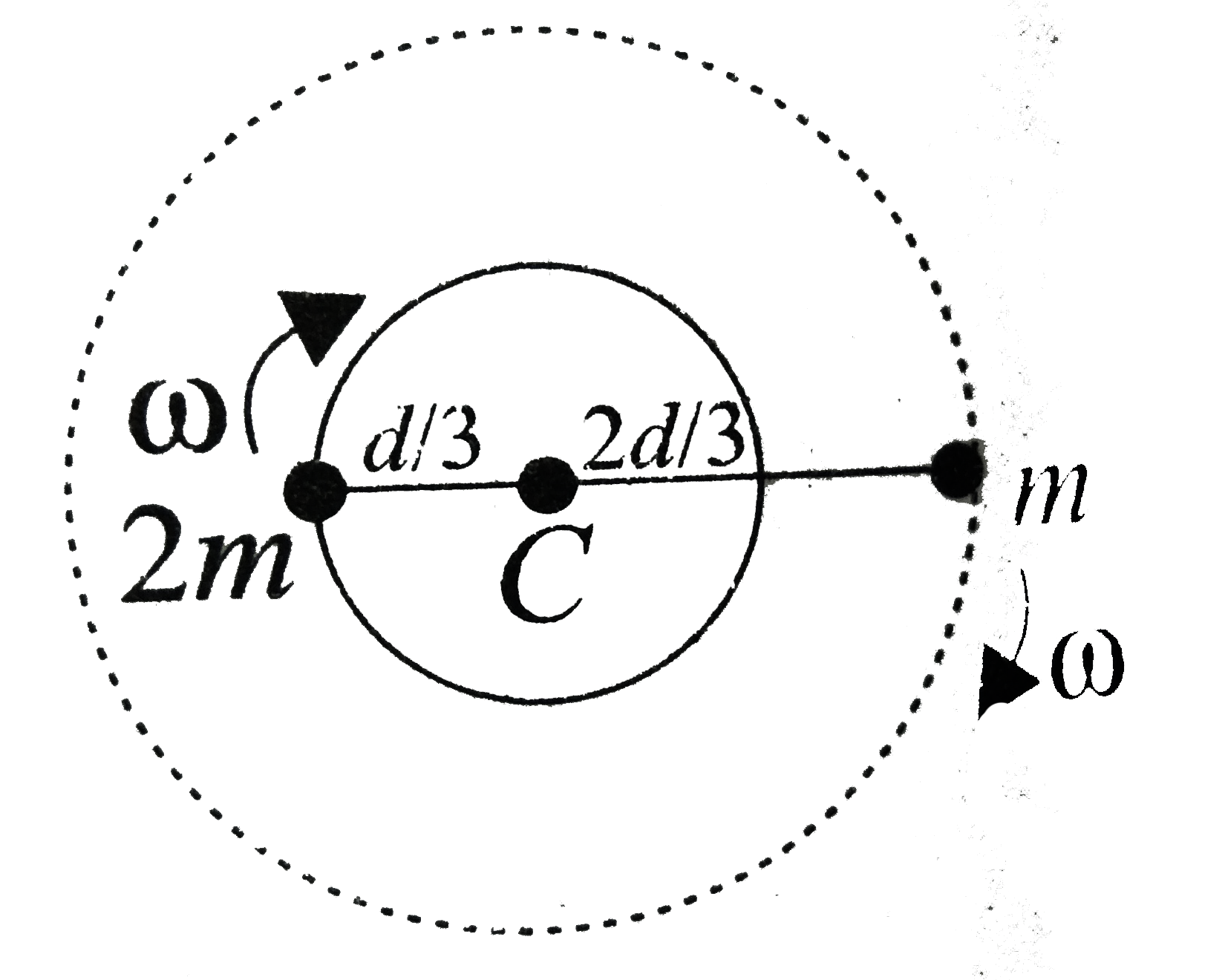In a double star, two stars (one of mass m and the other of mass 2m) distance d apart rotate about their common centre of mass., Deduce an expressioin for the period of revolution. Show that te ratio of their angular momenta about the centre of mass is the same as the ratio of their kinetic energies.
The centre of mass C will be at distance d/3 and 2d/3 from masses 2m and m, respectively. Both the stars rotate round C in their respective orbits with the same angular velocity ω. The gravitational force acting on each star due to the other supplies the necessary centripetal force.
The gravitational force on either star is G(2m)m/(d2). If We consider the rotation of the smaller star, the centripetal force
(mrω2)is[m(2d/3)ω2] and [(2mdω2/3)] for the bigger star, i.e., the same.
∴G(2m)md2=m(2d3)ω2 or ω=√(3Gmd3)
Therefore, the period of revolution is given by
T=2πω=2π√(d33GMm)
The ratio of angular momenta is
(Iω)big)(Iω)small=IbigIsmall=(2m)(d3)2m(2d3)2=12
Since ω is the same for both.
The ratio of their kinetic energies is
(12Iω2)big(1Iω2)small=IbigIsmall=12
which is the same as the ratio of their angular momenta.

Topper's Solved these Questions
- GRAVITATIONBOOK - CENGAGE PHYSICSCHAPTER - GRAVITATIONEXERCISE - Exercise 6.1
13 Videos
- GRAVITATIONBOOK - CENGAGE PHYSICSCHAPTER - GRAVITATIONEXERCISE - Exercise 6.2
15 Videos
- FLUID MECHANICSBOOK - CENGAGE PHYSICSCHAPTER - FLUID MECHANICSEXERCISE - INTEGER_TYPE
1 Videos
- KINEMATICS-1BOOK - CENGAGE PHYSICSCHAPTER - KINEMATICS-1EXERCISE - Integer
9 Videos
Similar Questions
In a double star, two stars one of mass m1 and another of mass m2, with a separation d, rotate about their common centre of mass. Find
(a) an expression for their time period of eavolution.
(b) the ratio of rheir kintic energies.
(c) the ratio of their angular momenta about the centre of mass.
(d) the total angular momentum of the system.
(e) the kinetic energy of the system.
View SolutionIn a double star system, two stars of masses m1 and m2 separated by a distance x rotate about their centre of mass. Find the common angular velocity and Time period of revolution.
View Solution
Knowledge Check
Two stars of masses m and 2m at a distance d rotate about their common centre of mass in free space. The period of revolution is :
A12π√d33GmB2π√d33GmC12π√3Gmd3D2π√3Gmd3In a double star system one of mass m1 and another of mass m2 with a separation d rotate about their common centre of mass. Then rate of sweeps of area of star of mass m1 to star of mass m2 about their common centre of mass is
Am1m2Bm2m1Cm21m22Dm22m21In a binary star system one star has thrice the mass of other. The stars rotate about their common centre of mass then :
ABoth stars have same angular momentum about common centre of massBBoth stars have angular momentum of same magnitude about common centre of massCBoth stars have same angular speedsDBoth stars have same linear speeds
A pair of stars rotates about a common centre of mass. One of the stars has a mass M and the other m. Their centres are a distance d apart, d being large compared to the size of either star. Derive an expression for the period of revolution of the stars about their common centre of mass. Compare their angular momenta and kinetic energies.
View SolutionIn a double star, two stars one of mass m1 and another of mass m2, with a separation d, rotate about their common centre of mass. Find
(a) an expression for their time period of revolution.
(b) the ratio of their kinetic energies.
(c) the ratio of their angular momenta about the centre of mass.
(d) the total angular momentum of the system.
(e) the kinetic energy of the system.
View SolutionTwo bodies of masses m1 and m2 have the same linear momentum. What is the ratio of their kinetic energies?
View SolutionTwo stars of masses m1 and m2 distance r apart, revolve about their centre of mass. The period of revolution is :
View SolutionTwo objects of masses 1kg and 2kg separated by a distance of 1.2m are rotating about their centre of mass. Find the moment of inertia of the system
View Solution
